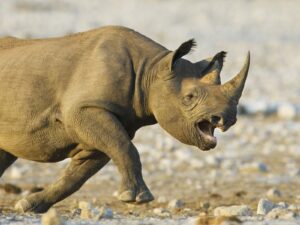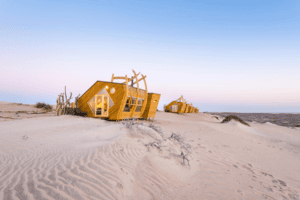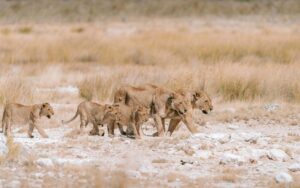Red sand dunes undulating across a landscape that never seems to end; only a few hardy plants are dotted around, as well as desiccated trees stretching into a clear, electric blue sky that provides a striking contrast with the fiery-hued land. This is Namibia, a destination famed for its desert safaris that will disconnect you from the world and connect you with nature and yourself. The animals found in Namibia add to the experience, creating a unique safari adventure you won’t find elsewhere.

Let’s explore the diverse and unique animal life of this southern Africa gem, highlighting their beauty, importance to the region, and where to find them while on a Namibia safari. Join us on a journey of discovery as we uncover the animals of Namibia.
An Overview of Namibia’s Unique Wildlife
The remarkable wildlife of Namibia can truly capture the imagination. Here, some of Africa’s iconic animals can be found, such as elephants, lions, giraffes, zebras, and hyenas. Other big cats to spot are leopards and cheetahs. In addition to these well-known creatures, Namibia’s diverse habitats are also home to some more unusual desert-adapted species, ranging from wild horses and oryxes to the strange aardvark, belligerent honey badger, and endangered pangolin.

However, arguably the most captivating of Namibia’s creatures are its birds. Namibia boasts around 700 birds to spot, including unique dry-country species like the dune lark, Rüppell’s bustard, and Damara red-billed hornbill. Along the coastline, large colonies of flamingos and pelicans can be found. The best time to experience a birdwatching safari in Namibia is between November and April when European and Asian migratory species can be seen in the country’s reserves and parks. During this time of the year, the landscape changes due to the increased rainfall, changing usually arid conditions to habitats suitable for waterbirds.

Animals of Namibia’s Savannahs
Etosha National Park, one of the best safari destinations in southern Africa, encompasses a salt pan and vast savannah landscapes. Here, herds of elephants can be seen walking across the landscape, as well as graceful giraffes and hyena packs. Antelope species such as elands, oryxes, and wildebeest are also common sights here and will often congregate near waterholes for both drinking and socialising with one another. Birders will enjoy raising their binoculars to spot more than 30 species of raptors that fly across the skies here.
Other members of the Big Five that can be spotted in Etosha are lions, leopards (although a rare sighting), and rhinos. Etosha Mountain Lodge, located in the Etosha Heights Private Reserve, offers safari-goers the extraordinary activity of rhino encounters. This experience will take you close to these incredible animals to witness them in their natural habitat.
Animals of Namibia’s Deserts
Namibia includes vast swathes of deserts where only a few hardy species thrive. While on a desert safari in places like the Hoanib Desert, Damaraland, and Namib-Naukluft National Park, you’ll have the opportunity to see desert-adapted wildlife like Hartmann’s mountain zebras, gemsboks, springboks, black-faced impalas, oryxes, and Damara dik-diks. On the predator front, keep an eye out for both spotted and brown hyenas and lions stalking the landscape, waiting for the perfect opportunity to strike for their next meal.

Animals of Namibia’s Coast
Skeleton Coast, one of Namibia’s most well-loved destinations, is where the desert meets the sea. A blanket of mist usually covers the landscape, except during the wet season, when the rain clears the air. A Namibia wildlife safari here is dominated by seal colonies – the Cape Cross Seal Colony is home to more than 200,000 seals!
If you’re lucky, you may see the lions of the Skeleton Coast hunting along the coastline, looking for a seal or waterbird. These desert-adapted lions are incredibly rare, and a lot of work goes into protecting them. Shipwreck Lodge, located along the Skeleton Coast, supports the Desert Lion Conservation Project to protect the desert-adapted lions of northwest Namibia from human-wildlife conflict. A stay at this accommodation contributes towards this incredible project.
Animals of Namibia’s Rivers
Namibia isn’t all desert. The Zambezi Region (also known as the Caprivi Strip) borders the Okavango Delta in Botswana and is a watery habitat where you can see crocodiles, hippos, and rare waterbucks. It’s also home to an array of other fascinating creatures that live in its rivers, including African pike, catfish, and carp, as well as a variety of amphibians, such as frogs.
Additionally, Namibia’s rivers provide habitats for birds like cormorants and terns, among other species of avifauna. Baboons, vervet monkeys, hyenas, and zebras can also be found near the banks of Namibian rivers. These waterways are lifelines; many animals gather around water sources, with permanent ones being extremely popular in the dry season.
Conservation Efforts by Locals and Organisations
Namibia has become a leader in community-based conservation efforts. Namibians and NGOs alike have come together to protect their stunning landscapes and prevent the over-exploitation of natural resources. The country has seen a dramatic increase in its wildlife population from the combined works of these organisations, allowing Namibia to showcase pristinely preserved habitats with ample biodiversity in both flora and fauna. Namibian communities involved have also been able to create viable economic opportunities from sustainable tourism.

The animals of Namibia are truly remarkable and have captivated visitors from all over the world. From antelopes to crocodiles, Namibian wildlife has flourished thanks to a combination of government initiatives and community-based conservation efforts. These animals are an important part of Namibian culture, are integral to the country’s natural beauty, and have acted as symbols of national pride for many generations.
With continued support from tourism, local Namibians, organisations, and government initiatives, we can ensure that these animals remain a part of this incredible landscape for years to come.
Author: Gavin Denner
Published:
Last Update:
Part of the Namibia Safari Collection